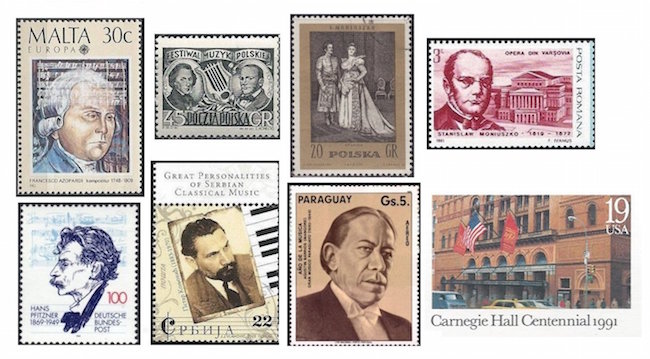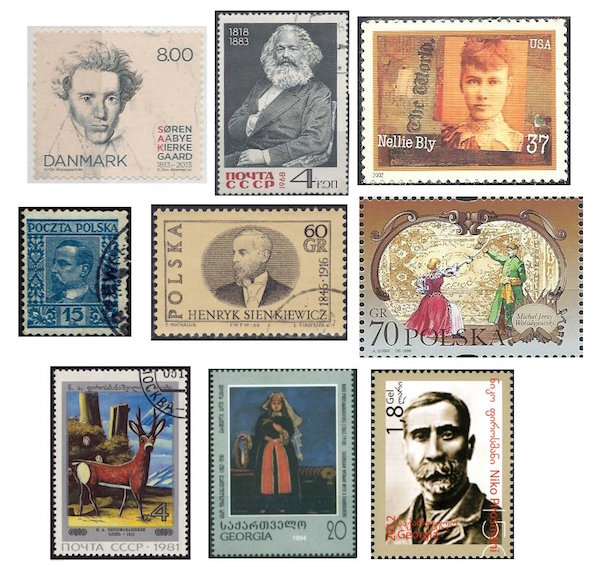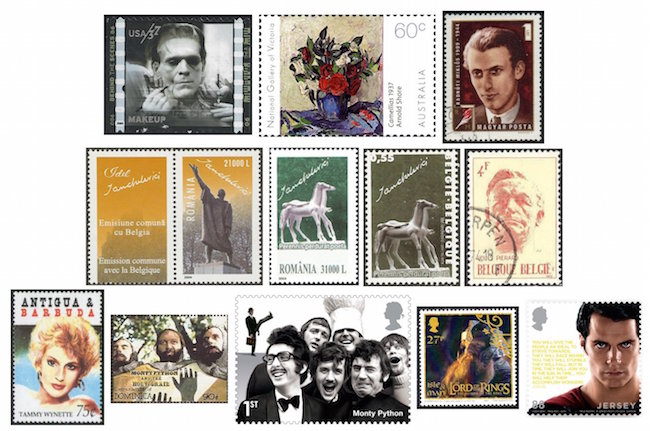The Arts on the Stamps of the World — May 5
An Arts Fuse regular feature: the arts on stamps of the world.

By Doug Briscoe
No fewer than five (!) composers share this 5/5 birthday. We also have six artists (representing a variety of genres) and four entertainers. May 5 is also the date on which Carnegie Hall officially opened. Let’s start with the composers.
Francesco Azopardi (1748 – 6 February 1809) was Maltese, though he worked in Naples for a while, and besides his liturgical works, an opera (La magica lanterna, 1791), and two symphonies (1797 and 1799), he wrote treatises on music.
Polish composer Stanisław Moniuszko (sta-NEE-swahf mon-YOOSH-ko; 1819 – June 4, 1872) was born to the nobility in what today is Belarus. Active as a conductor and organist, he concentrated on opera and art songs. In 1951, Poland issued a pair of stamps (we see just one) for the Festival of Polish Music, each offering portraits of both Moniuszko and Chopin. In 1972, the centenary of Moniuszko’s death, Poland issued a handsome set of eight stamps (again, just one is on offer today) depicting some of his many stage works. The Romanian stamp comes from a 1985 block of four commemorating opera composers.
Hans Pfitzner (1869 – 22 May 1949) is an interesting historical study. Because he was a strong German nationalist and had friends among and sought patronage from the Nazi establishment, he has often been condemned as a sympathizer; yet he had the temerity to contradict Hitler to his face and on another occasion to refuse to write music to replace Mendelssohn’s. In consequence he was shunned by the party and frustrated in his career. His best known work is likely Palestrina (premièred 1917), the fourth of his five operas. He also wrote three symphonies, three cello concertos, four string quartets, and about a hundred Lieder (which last I must confess I find tedious listening).

The modernist Serbian composer Petar Konjović (KON-yo-vitch; 1883 – 1 October 1970) managed several Yugoslav theaters. Like Pfitzner, he, too, wrote five operas and many songs, mainly folk song arrangements, but there are also a symphony (1907), a violin concerto, two string quartets, choral works, etc.
Agustín Barrios (1885 – 7 August 1944) is well known to lovers of guitar music. Born in Paraguay, he took up the guitar from the age of seven. He made some of the earliest classical guitar recordings in history (1909) and composed 300 pieces for the instrument.
Keeping to our classical music theme, we wrap up the first collage with a postal card celebrating the centenary of the official opening night of Carnegie Hall, May 5, 1891. The inaugural concert was conducted by Walter Damrosch and a guest from Russia, one Pyotr Ilyich Tchaikovsky. I’ve trimmed the image to show just the upper right corner of the postal card.
Now before we move on to other disciplines, we pause for a brief nod to three figures who had a bit of influence here and there and who had a hand in literature of one kind or another. Both Søren Kierkegaard (5 May 1813 – 11 November 1855) and Karl Marx (5 May 1818 – 14 March 1883) dabbled in poetry. Now there’s a project for you: translate Fear and Trembling and Das Capital into rhyming couplets. The third figure is one of the progenitors of investigative journalism, Nellie Bly (née Elizabeth Cochran Seaman on May 5, 1864, died January 27, 1922). A recent novel about her by Dan Jorgensen, And The Wind Whispered, came out in 2015.
Henryk Sienkiewicz (syen-K’YEH-vitch; 5 May 1846 – 15 November 1916) is the Nobel Prize winner who wrote Quo Vadis (1896). He was born to the impoverished Polish nobility. His school grades were rather poor except in two areas that stood him in good stead: Polish language and history. In a reversal of the usual progression, it seems he wrote novels before journalism, though making his name in the latter field first, sometimes using the pen name “Litwos”. The Polish Gazette paid for his 1876-78 visit to the United States, whence he sent back travel pieces and continued writing fiction. He was only 33 when the first edition of his collected works appeared in print. Sienkiewicz was awarded the Nobel Prize for Literature (not specifically for Quo Vadis) in 1905. Two stamps honoring the man are joined by one from a block remembering some of his creations.

Georgian primitivist painter Niko Pirosmani, known also as Niko Pirosmanashvili or simply Nikala, was born on May 5, 1862. His parents were farmers, but on being orphaned he entered domestic service and learned to read and write Georgian and Russian. As a painter he was self-taught and tended to work on oilcloth. He earned some fame from his work, but little money, and died of malnutrition and liver failure on April 9, 1918. No sooner did World War I end than his reputation bloomed. Philatelically, his work can be seen on a 1981 Soviet stamp (Autumn, 1913) and in a set of ten stamps issued by Georgia in 1994, from which I’ve selected one, Georgian Woman With a Tambourine (1906). The artist himself is seen on a later Georgian issue, printed “2012” and clearly intended as a sesquicentennial issue but not actually released until the following year.
Now for an Arts on Stamps of the World first: an homage to a Hollywood makeup artist. Greek-born Jack Pierce (born Janus Piccoula; May 5, 1889 – July 19, 1968) is the man who crafted the universally recognized makeup for Boris Karloff in James Whale’s Frankenstein (1931). Earlier, Pierce had created the eerie fixed grin for Conrad Veidt in The Man Who Laughs (1928), and later, he would be responsible for both The Mummy (1932) and The Wolf Man (1941). The stamp, giving us a peek at Mr. Pierce’s hand and pencil, comes from a 2003 sheet saluting American filmmaking “behind the scenes”.
The Australian artist and critic Arnold Shore (1897-1963) was a designer of stained glass in his youth. Later he became a member of the Twenty Melbourne Painters and held what has been cited as the first modernist exhibition in Melbourne. Online information about him is very scarce, but there’s an appreciation by R. Dedman. The stamp shows his Camellias of 1937.

Hungarian poet Miklós Radnóti (5 May 1909 – 10 November 1944) was born and died in tragedy. His mother and twin brother both expired at his birth, and Radnóti was a Holocaust victim. Born Miklós Glatter to a family of assimilated Jews, he always viewed his identity as Hungarian and converted to Catholicism the year before his death, but that was probably more a political move than a religious one. It was no use. Conscripted into the Hungarian army as a laborer, he served on the Russian Front and in copper mines in Serbia before being force-marched back toward Hungary. He was shot to death along the way, as were many of his fellows, and buried in a mass grave. After the war the grave was opened, and a packet of poems was found in his greatcoat. He did publish six volumes of verse before the war. The one ray of sunshine in this story seems to have been Radnóti’s happy marriage.
Idel Ianchelevici (yahn-keh-LAY-vich; 5 May 1909 – 28 June 1994) was another Jewish artist, ethnic Romanian, born in Bessarabia in what was then the Russian empire. He relocated to Belgium in 1928 and was awarded first prize in statuary from the Académie des beaux-arts in Liège in 1933. After that he had a number of shows in Tel-Aviv, Paris, Amsterdam, and elsewhere. During the occupation he sought refuge in the small town of Maransart with a woman who led a Resistance group. Ianchelevici acquired Belgian citizenship in 1945 and worked for a time in the Belgian Congo. From 1950 he resided in France. The stamps shows us his L’Appel of 1939 (cast in bronze in 1967). According to Radio Canal du Centre’s webpage it symbolizes the striving for reason, civilzation, and spiritual force. Next, on stamps of both Romania and Belgium, we see Perennis perdurat poeta (1970). Finally, another Belgian stamp honors Walloon Movement politician and journalist Louis Pierard with a bust executed by Ianchelevici.
Now for today’s entertainers. We have stamps for American country music singer Tammy Wynette (May 5, 1942 – April 6, 1998), Monty Python alum and author Michael Palin (5 May 1943—he’s at right on the Dominican Holy Grail stamp and at center on the British one), and British actors John Rhys-Davies (born 5 May 1944) in his Gimli get-up from The Lord of the Rings trilogy and Henry Cavill (born 1983) in his Superman costume from Man of Steel (2013). You may know him also as Charles Brandon, 1st Duke of Suffolk in The Tudors.
A graduate of the University of Massachusetts with a B.A. in English, Doug Briscoe worked in Boston classical music radio, at WCRB, WGBH, and WBUR, for about 25 years, beginning in 1977. He has the curious distinction of having succeeded Robert J. Lurtsema twice, first as host of WGBH’s weekday morning classical music program in 1993, then as host of the weekend program when Robert J.’s health failed in 2000. Doug also wrote liner notes for several of the late Gunther Schuller’s GM Recordings releases as well as program notes for the Boston Classical Orchestra. For the past few years he’s been posting a Facebook “blog” of classical music on stamps of the world, which has now been expanded to encompass all the arts for The Arts Fuse.
